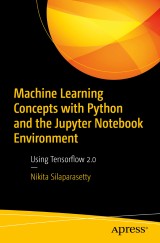Details

Machine Learning Concepts with Python and the Jupyter Notebook Environment
Using Tensorflow 2.0|
66,99 € |
|
| Verlag: | Apress |
| Format: | |
| Veröffentl.: | 21.09.2020 |
| ISBN/EAN: | 9781484259672 |
| Sprache: | englisch |
Dieses eBook enthält ein Wasserzeichen.
Beschreibungen
<div><ul><li><ul> </ul></li></ul><p>Create, execute, modify, and share machine learning applications with Python and TensorFlow 2.0 in the Jupyter Notebook environment. This book breaks down any barriers to programming machine learning applications through the use of Jupyter Notebook instead of a text editor or a regular IDE.</p><p>You’ll start by learning how to use Jupyter Notebooks to improve the way you program with Python. After getting a good grounding in working with Python in Jupyter Notebooks, you’ll dive into what TensorFlow is, how it helps machine learning enthusiasts, and how to tackle the challenges it presents. Along the way, sample programs created using Jupyter Notebooks allow you to apply concepts from earlier in the book.</p><p>Those who are new to machine learning can dive in with these easy programs and develop basic skills. A glossary at the end of the book provides common machine learning and Python keywords and definitions to make learning even easier.</p><p><b>What You Will Learn</b></p><ul><li>Program in Python and TensorFlow</li><li>Tackle basic machine learning obstacles</li><li>Develop in the Jupyter Notebooks environment</li></ul><p></p><p><b>Who This Book Is For</b></p><p>Ideal for Machine Learning and Deep Learning enthusiasts who are interested in programming with Python using Tensorflow 2.0 in the Jupyter Notebook Application. Some basic knowledge of Machine Learning concepts and Python Programming (using Python version 3) is helpful. <br></p></div><div></div>
<div><p>Chapter 1: An Overview of Artificial Intelligence.- Chapter 2: An Overview of Machine Learning.- Chapter 3: Introduction to Deep Learning.- Chapter 4: Machine Learning Versus Deep Learning.- Chapter 5: Machine Learning with Python.- Chapter 6: Introduction to Jupyter Notebooks.- Chapter 7: Python Programming on the Jupyter Notebook.- Chapter 8: The Tensorflow Machine Learning Library.- Chapter 9: Programming with Tensorflow 1.0.- Chapter 10: Introducing TensorFlow 2.0.- Chapter 11: Machine Learning Programming with TensorFlow 2.0.</p></div>
<b>Nikita Silaparasetty</b> is a Data Scientist and an AI/Deep Learning Enthusiast specializing in Statistics and Mathematics. She is presently the head of the Indian based ‘AI For Women’ initiative, which aims to empower women in the field of Artificial Intelligence. She has strong experience programming using Jupyter Notebooks and a deep enthusiasm for TensorFlow and the potentials of Machine Learning. Through the book, she hopes to help readers become better at Python Programming using Tensorflow 2.0 with the help of Jupyter Notebooks, which can benefit them immensely in their Machine Learning journey.
Understand the fundamental concepts of machine learning with Python and TensorFlow 2.0, within the Jupyter Notebook environment. Even if you’re an absolute beginner, develop a strong understanding of the crucial ideas without feeling intimidated by the immensity of the sector.<div><br></div><div>Start with a gentle introduction to artificial intelligence and machine learning to understand how the field has grown over the years and why it is still relevant. Then learn how the notebook interface has become increasingly popular for writing code—with Jupyter Notebook being preferred to a regular text editor or IDE.</div><div><br></div><div>Once these topics have been covered, you’ll dive into the TensorFlow 2.0 library. Obtain a good understanding of what TensorFlow is, and how it has improved from its initial release. You’ll be able to compare the two versions in a theoretical as well as practical way, and you’ll go through the procedure required to convert code from TensorFlow 1.0 to TensorFlow 2.0.</div><div><br></div><div>Finally, you will work through projects that use TensorFlow 2.0 with Python and the Jupyter Notebook to help build your own neural networks for deep learning. This will enable you to put everything that you have learned from the book into practice. Each project is given in a step-by-step format for better comprehension.</div>
Gain comfort in the Jupyter Notebooks environment, which makes programming in Python even easier Build a basic understanding of more complex Machine Learning concepts and how TensorFlow simplifies them in practice Program advanced applications using the familiar Python language
-
-
© 2024 media control GmbH
Alle Preise enthalten die gesetzliche Mehrwertsteuer. - AGB
- Impressum
- Datenschutzerklärung
- Kontakt
- FAQ
- Mein Konto
- Home
- Erweiterte Suche
- Widerrufsrecht
- Reader-Software
- Desktop-Ansicht
- Gutschein-Code einlösen


